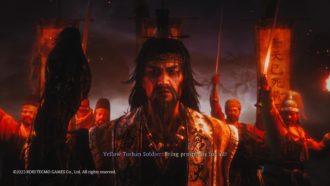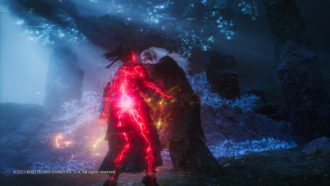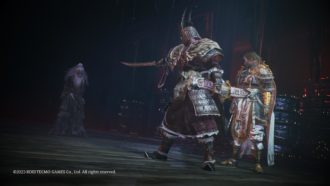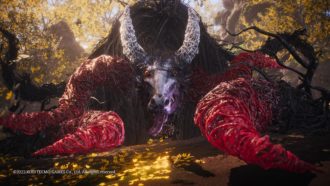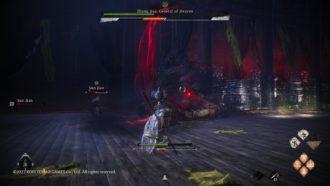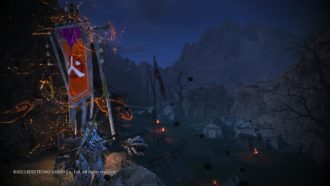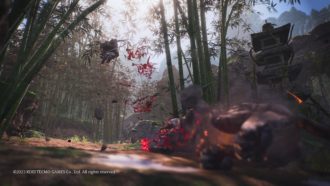Platforms:
Xbox One, PS4, PC, PS5, Xbox Series X|S
Released:
March 3, 2023
Publisher:
Koei Tecmo
Developer:
Team Ninja
Team Ninja return with Wo Long: Fallen Dynasty, another highly challenging masocore game. The fast-paced, gruelling action game demands skill, strategy and mastery of many gameplay mechanics. Taking elements of their successful Nioh franchise, this experience is one for determined audiences.
The Three Kingdoms era like never before
Enter the turbulent world of 184 AD China during the Later Han Dynasty, where chaos and destruction have consumed the land, and the once-prosperous imperial dynasty is on the brink of collapse. As a nameless militia soldier, you must survive the Three Kingdoms’ mayhem by using swordplay based on Chinese martial arts to battle fierce warriors and deadly demons. The game blends the past, fantasy, and action along the journey but brace yourself for the challenges standing in the way.
“Many of these beings are gigantic, relentless horrors that are imaginative in their illustrative and gameplay design.”
The most interesting part of this quest is the use of historical characters, places and events. From the first mission, you will be facing the Yellow Turban Rebellion which was a real group that revolted in this era of China. Other characters are also famous figures, such as the military general Zhao Yun who will fight as an ally in impressive armour and Zhang Liao who is one of the strongest adversaries in the game. Set in the early days of the Three Kingdoms, the story grows these legends into the figures they are today through creative representations of their milestone moments.
Fantasy brings a magical twist to the setting. In this version of China, divine power and demons keep the game appealing and incorporate ancient mythos. One of the main antagonists, a mystical man named Yu Ji, turns a civilian into the dragon Xielong which has ties to traditional Chinese dragon stories. That’s not the only creative boss in the game. Many of these beings are gigantic, relentless horrors that are imaginative in their illustrative and gameplay design. There is clearly so much detail and attention to the lore of Wo Long: Fallen Dynasty which fans of the era will absolutely adore.
While the content of the story is fantastic, it isn’t a well-crafted narrative. The main goal to stop the darkness and demons causing havoc is an old and tried tale. Besides one or two exceptions, the characters met throughout the adventure aren’t memorable and will often come and go without much meaning. Sitting at roughly 30 hours to complete, the campaign and its side quests are clearly not driven by the narrative but the striking gameplay and mechanics.
From lowly militia to heroic legend
Wo Long: Fallen Dynasty offers a great character customiser with varied options. After selecting a new game and watching the opening cutscene, a true warrior or monstrous being can be made through a range of facial, body, hair, voice and accessory styles and design tools. Creations can be saved, shared, and replicated for players to embody new characters. Not only is it fun to make the ultimate ancient warrior but the customiser tool shows off impressive character models and textures.
The tutorial mission Village of Calamity sets the dark tone and fast pace for the rest of the experience. With many mechanics and systems thrown at the screen fairly quickly over this short level, the game can be very intimidating and complex at first. While the enemies aren’t challenging to start, there’s just a bit too much information to absorb straight away with how detailed the systems can be. A slower and stretched tutorial may benefit new players to the genre and world much better.
From here, the campaign can be linear or players can travel to other missions across the map. By visiting one of many Battle Flags, posts that are conquered after clearing out a group of enemies, a map of the kingdom with different side quests and enemy zones to dominate can be played. Being able to choose a mission is a smart way to allow players to personalise their experience, especially when trying to find extra Dragon’s Cure Pots or grind for Genuine Qi to overcome the next tricky boss.
Genuine Qi are experience points collected by defeating enemies. Accumulating a certain amount allows the player to level up one of Five Phases which represent a category of stats: Wood, Fire, Earth, Metal and Water. These levels will boost strength against more challenging missions and enable more powerful weapons or abilities to be used. As is the trend, players lose half of their Genuine Qi upon death but can reclaim lost XP by defeating the same enemy. It’s not a critical loss like losing all currency in Elden Ring, but it does offer a reasonable punishment for reckless combat and will make foes stronger.
“That’s one of the biggest concerns with Wo Long: Fallen Dynasty – the difficulty is inconsistent.”
That’s one of the biggest concerns with Wo Long: Fallen Dynasty – the difficulty is inconsistent. Some missions and bosses will be an outright breeze and others will feel entirely unbeatable. There’s clearly been balancing to the start of the game from the negative feedback about how difficult the demo was, yet not completely throughout the experience. A point in the campaign has a significant difficulty spike and this might deter players who aren’t looking to spend time backtracking and grinding for more levels.
Similar to From Software games, Battle Flags are resting points between fights with a menu of upgrades, item management, recruitment, online play, and missions to select. There are also Marking Flags hidden throughout the stages and discovering them allows you to increase your Fortitude Rank, just like a Battle Flag. By finding them all in each stage, you will become stronger as the Fortitude and base Morale Rank will rise.
Morale Rank defines player strength in an individual mission. It grows higher the more demons are defeated, taking less damage as the rank increases to a max of 25. Additional special abilities called Wizardry Spells become usable as that number raises throughout each mission, meaning every stage has its own siloed progression. Being hit or dying will lower the player’s Morale Rank and raise the enemy’s making them an even tougher battle.
The system is an intriguing way to balance player strength in each mission and encourage replayability. Still, it adds an excessive complication when there are so many other stats, currencies, and levels to monitor and think about.
Unleash your inner warrior
Combat is based upon 13 weapon categories, varying from quick and weaker weapons like sabres to heavy-hitting slow-movers like poleaxes. Each have efficiencies, elemental affinities, and deflections rates which are the important basic stats to worry about. Strong weapons will allow players to deal with demons easier and timing parries properly is essential for critical attacks. Some bosses can only be defeated by deflecting their nearly vital attacks which makes it the most effective skill to learn. Higher-ranked weapons may come with Martial Arts, distinctive moves that can also pack a powerful punch with an area of effect.
Magical moves can imbue these weapons with Spirit when using Martial Arts, Wizardry Spells and Spirit Attacks. This is measured by a gauge on the screen that teeters orange when depleted and blue when increased. Spirit is the main mechanic of combat and correct management is the key to success. Players become vulnerable and stunned when spamming Spirit-based attacks and getting hit too many times, whereas deflecting accurately and eliminating enemies will keep the gauge blue and maintain that mystical momentum. The Spirit Gauge adds a strategic layer to combat that deepens its other mechanics.
“…layer upon layer of mechanics that makes combat intricate.”
Wizardry Spells align with the elements of the Five Phases. They are unlocked via another skill tree that earns points every five levels gained in an individual element. By planning ahead and targeting a boss’ weak elements and status effects, the player can gain the upper hand in otherwise demanding battles. They can also provide buffs or changes to movement, which will aid in traversal and finding hidden flags or loot which makes them a useful tool in exploration and combat.
For some extra help, players can summon Divine Beasts as an ultimate attack. Another gauge is filled when enemies are defeated, damage is dealt or taken, or a Fatal Strike hits which bring the Divine Beast closer to being unleashed. When activated, they can have a devastating physical effect or grant a buff to the player and allies. Divine Beast Qilin can create rock pillars in front of the player upon being summoned and decimate any monster in proximity. Divine Beasts are well-balanced in combat, accumulating at an appropriate speed to keep those exhilarating damaging moves constant throughout levels without feeling the need to hold onto a full meter for a dangerous enemy.
Continually hitting enemies with elemental attacks like Wizardy Spells or Divine Beasts will put them under a status effect. It leaves monsters or warriors open to attack and induces them into a state of shock, burn, heaviness, poison or chill. Of course, this isn’t exclusive and the same effects can strike you as well. Status effects are incredibly useful to keep the damage on strong enemies but may also leave the player in dire straights if not defended against. It’s another layer upon layer of mechanics that makes combat intricate.
Mythical creatures and fearsome foes
Friends can be called upon to overcome challenging areas or bosses. Using a Tiger Seal, up to two allies with their own specialisations or online players can join the world. When an ally warrior is present a buff effect, like using less Spirit when deflecting, is applied. Computer-controlled allies and online co-op works very well – too well. When playing with another character the game will often become relatively easy. Enemy AI focusing on one player leaves them open for a barrage of damage which can make even the most difficult bosses a simple fight. While it may offset those notoriously challenging moments solo, it still doesn’t feel fair to win because of bad AI.
Invading is another online option that becomes available only a few hours into the story. As expected, players visit others in the middle of missions and cause chaos as they try to complete objectives. Invasions can be repelled by defeating the leader and claiming their Battle Flag or by defeating all invaders. It’s fantastic that online invasions can be turned off if desired and instead an NPC who is generally an easy target will occasionally occupy the world. While it is fun to invade others, it doesn’t offer nearly as much incentive as other games with similar modes.
Vengeance targets, hazy purple graves of fallen warriors, will litter the battlefield and allow players to take revenge on the foe that defeated them. By sacrificing a Dragon’s Cure Pot and receiving a Morale Rank boost, a player can accept the target and reap rewards if successful. Vengeance targets are not only fun distractions but a smart way to show where difficult enemies might be hiding in the busy world.
8
Great
Positive:
- Thrilling combat against monstrous bosses
- Historical setting with a magical twist
- Fun online and co-op gameplay
- Great character customisation
Negative:
- Difficulty balancing issues
- A few too many systems
- Narrative is a little weak
Team Ninja has created a challenging and engaging action game in a fantasy version of Three Kingdoms China. The combat mechanics are intuitive and all work together, making strategy and consideration of each next big boss fight vital. However, those same systems can be overly complex with a flurry of gauges, ranks, and stats to consider all at once. Even with a few difficulty spikes and balancing issues, Wo Long: Fallen Dynasty is still a fun adventure with creative bosses and exciting battles.
